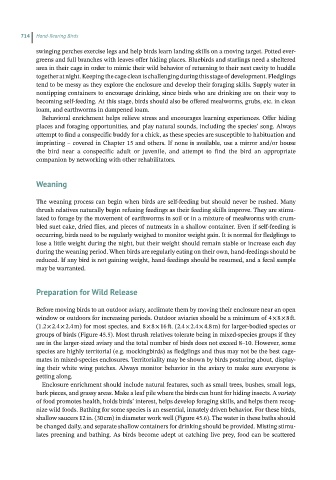Page 712 - Hand rearing birds second
P. 712
714 Hand-Rearing Birds
swinging perches exercise legs and help birds learn landing skills on a moving target. Potted ever-
greens and full branches with leaves offer hiding places. Bluebirds and starlings need a sheltered
area in their cage in order to mimic their wild behavior of returning to their nest cavity to huddle
together at night. Keeping the cage clean is challenging during this stage of development. Fledglings
tend to be messy as they explore the enclosure and develop their foraging skills. Supply water in
nontipping containers to encourage drinking, since birds who are drinking are on their way to
becoming self‐feeding. At this stage, birds should also be offered mealworms, grubs, etc. in clean
loam, and earthworms in dampened loam.
Behavioral enrichment helps relieve stress and encourages learning experiences. Offer hiding
places and foraging opportunities, and play natural sounds, including the species’ song. Always
attempt to find a conspecific buddy for a chick, as these species are susceptible to habituation and
imprinting – covered in Chapter 15 and others. If none is available, use a mirror and/or house
the bird near a conspecific adult or juvenile, and attempt to find the bird an appropriate
companion by networking with other rehabilitators.
Weaning
The weaning process can begin when birds are self‐feeding but should never be rushed. Many
thrush relatives naturally begin refusing feedings as their feeding skills improve. They are stimu-
lated to forage by the movement of earthworms in soil or in a mixture of mealworms with crum-
bled suet cake, dried flies, and pieces of nutmeats in a shallow container. Even if self‐feeding is
occurring, birds need to be regularly weighed to monitor weight gain. It is normal for fledglings to
lose a little weight during the night, but their weight should remain stable or increase each day
during the weaning period. When birds are regularly eating on their own, hand‐feedings should be
reduced. If any bird is not gaining weight, hand‐feedings should be resumed, and a fecal sample
may be warranted.
Preparation for Wild Release
Before moving birds to an outdoor aviary, acclimate them by moving their enclosure near an open
window or outdoors for increasing periods. Outdoor aviaries should be a minimum of 4 × 8 × 8 ft.
(1.2 × 2.4 × 2.4 m) for most species, and 8 × 8 × 16 ft. (2.4 × 2.4 × 4.8 m) for larger‐bodied species or
groups of birds (Figure 45.5). Most thrush relatives tolerate being in mixed‐species groups if they
are in the larger‐sized aviary and the total number of birds does not exceed 8–10. However, some
species are highly territorial (e.g. mockingbirds) as fledglings and thus may not be the best cage-
mates in mixed‐species enclosures. Territoriality may be shown by birds posturing about, display-
ing their white wing patches. Always monitor behavior in the aviary to make sure everyone is
getting along.
Enclosure enrichment should include natural features, such as small trees, bushes, small logs,
bark pieces, and grassy areas. Make a leaf pile where the birds can hunt for hiding insects. A variety
of food promotes health, holds birds’ interest, helps develop foraging skills, and helps them recog-
nize wild foods. Bathing for some species is an essential, innately driven behavior. For these birds,
shallow saucers 12 in. (30 cm) in diameter work well (Figure 45.6). The water in these baths should
be changed daily, and separate shallow containers for drinking should be provided. Misting stimu-
lates preening and bathing. As birds become adept at catching live prey, food can be scattered

